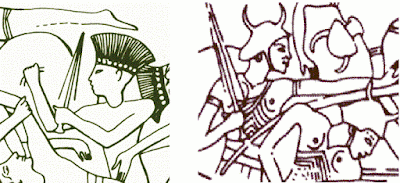Two thousand years before the Vikings set sail, a group of maritime warrior ruled the seas. During the height of the Bronze Age, many of the Mediterranean cities were enjoying peace and prosperity, as well as stable trade by land and sea. And then, there came the Sea Peoples.
 |
| Image source. |
These seafarers invaded cities from Anatolia to Egypt during the centuries between 1200 – 20 BC, and were responsible for the destruction of the Hittite Empire, among others.
You can also watch my Youtube Video here:
Who were the Sea Peoples?
 |
| Drawings of two Sea Peoples tribes. Source. |
Despite the havoc wreaked by the Sea Peoples, there is precious little known about them. We do not know much about their culture or nationality, nor did they leave any written records. From fragmented history written by their enemies, it is generally believed that they were a band of peoples from various lands. During their time, they were not referred to as “Sea Peoples.” Various sources have called them Sherden, the Tursha, the Lukka, the Sheklesh, or the Akawasha. Despite these various names, the origin of the Sea Peoples remains mysterious to this day.
Some of the Sea Peoples are said to have been veterans from the battle of Troy, while another of the Sea Peoples tribes is generally believed to have been the biblical Philistines.
The Sea Peoples’ Destruction of the Ancient World
 |
| Artist depiction of war against the Sea Peoples. Image Source. |
Most of what we know about the Sea Peoples comes from Egyptian records. An inscription by Ramses II at around 1200 BC reads: “They came boldly sailing in their warships from the midst of the sea, and none could withstand them.” According to various historical records, the Sea Peoples laid waste to many thriving cities of the ancient world, including cities in Turkey, Syria, Cyprus, and Egypt.
Another narrative from during the 19th dynasty reads that the depreciation of certain regions was so severe that “it was forsaken as pasturage for cattle, and left waste from the time of the ancestors.”
 |
| A map of Sea People's invasions; Wikimedia Commons |
Yet another Hieroglyphic text by Ramses III speaks of a great movement of the Mediterranean people, saying “the lands were removed and scattered to the fray. No land could stand before their arms, from Hatti, to Kode, Arzawa (two cities in Anatolia,) Carchemish (Syria), and Alasiya (Cyprus).
A letter by Ammurapi, last King of the Hitites, is preserved in a clay tablet. It was a response to the king of Alasiya requesting for assistance.
It read: “The enemy’s ships came here. My cities were burned. They did evil things in my country… the country is abandoned to itself. May you know, 7 ships of the enemy came here and inflicted much damage…”
The Hittite Empire came to an end in approximately 1180 BC. Alashiya was plundered by the Sea Peoples and ceased to exist in 1085 BC.
The Collapse of the Bronze Age
 |
| Bronze Age Egypt. Source. |
After 2,000 years of prosperity in the Mediterranean region, the Sea Peoples brought that era to an end. Aside from the great destruction caused by the Sea Peoples, probably one of the main effects was the disruption of trade. This meant that many regions were not able to get the tin needed to alloy with copper to create bronze. Some historians attribute the dawn of the Iron Age to this factor.
The final demise of the Sea Peoples
 | |
| The battle of the Delta; Wikimedia Commons |
The Battle of Djahy (Zahi) was a major battle between the Sea Peoples and the armies of Ramses III. During this time, the Sea Peoples had been attacking the coasts of various Mediterranean cities, to the demise of such as the Hittite Empire, and the city of Alashiya. According to Egyptian inscriptions, “no other country could withhold their attacks.”
Prior to this battle, the Sea Peoples had attacked a neighboring city on the Egyptian border, giving the Pharaoh time to plan his strategy. As he notes, “I equipped my frontier at Zahi and prepared before them… our charioteers were ready before hand… ready to crush the (invaders) under their feet.”
While this battle was a victory for Egypt, the war with the Sea Peoples was not over yet.
In 1175 BC, during The Battle of the Delta, Ramses III lured the Sea Peoples into the mouth of the Nile, where they were ambushed by a waiting fleet and ranks of archers on land. The Egyptian fleet pushed the Sea Peoples boats towards the shore, where they were devastated by archers and infantry. Ramses III proclaimed, “They were dragged, overturned, and laid low upon the beach… while all their things were cast upon the water.”
 |
| Egyptian carving depicting capture of the Sea People; Wikimedia Commons |
This victory at the Delta saved Egypt from the fate that befell Anatolia, The Hitites, and Alasiya.


0 comments:
Post a Comment